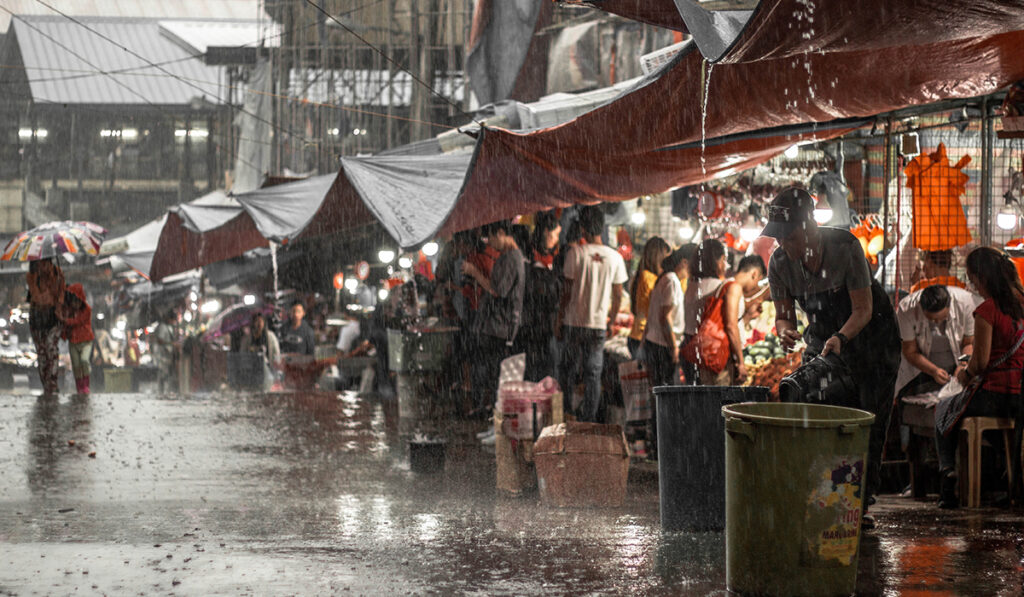The idea of retiring to the Philippines is not something that comes up when a person is thinking about where to retire. Most retirees from western countries are generally satisfied living out the rest of their lives in their home countries but there is a small portion that find the idea of retiring in a foreign country very appealing. A lot of retirees never consider moving to the Philippines which I feel is a mistake.
First off, retiring in a foreign country, especially retiring in the Philippines is not something that would appeal to everybody. It was almost 15 years before my actual retirement day that I started dreaming of what my life will be like not having to report to work on a regular basis. I dreamed of all the free time I would have and what I wanted to do with it. I am like most people when the idea of where to retire is brought up I envision lying in a hammock that is tied to two palm trees located on a white sand beach with the ocean waves gently lap up to the shore. Not only can you find that in the Philippines, but the Philippines offers so much more.
Moving to a foreign country is a major life decision and there are three main factors that you should consider. One is the climate, regardless of whether you like it warm or like it cold, moving to another country involves an adjust to the climate. The second factor is the culture things always operate differently in the foreign country than they do in your home country. And finally, the third factor and one that comes to people’s minds first is the economy of the country, can you afford the lifestyle that you want to live.
Before you make a final decision on where to spend your golden days, I would encourage you to explore the option of retiring to the Philippines. Whether it is on a half time or full-time basis, I believe that you will come to love the Philippines and consider it your adopted second home, just as I have. Let us explore each of three factors, the good and the bad on why one would want to consider retiring to the Philippines.
Moving to the Philippines for the Culture

The culture of the Philippines is unique in that is a combination of influences of Spanish, Asian and western countries such as the United States. The people of the Philippines are a proud people who take great value in how they are perceived in the public eye. As a foreigner it is wise not to cause public embarrassment to a local, this is good advice regardless of what country you are in. In general, the people of the Philippines have a more group mentality than an individual one. Unlike life in my home country, the United States, the idea of having “alone time” never really comes to the mind of the people of the Philippines, its all about family.
One can think of the saying, “the more the merrier” as a main aspect of Philippine culture whereas in most western countries the citizens value their privacy. For many in the Philippines, when one thinks of having his or her own space runs against what the Philippine culture believe. The culture of the Philippines places a big emphasis on family unity so unlike the western countries, it is not unusual for sons and daughters to live in their parents’ home well into their adult lives. They have a saying in the Philippines that when you marry the girl you marry the whole family.
The Philippine population is very friendly and hospital group of people and are quick to help those in need. It is not uncommon for complete strangers to be invited off the street and welcome into their home to be part of a family celebration. The Philippine people love to celebrate with numerous festivals, parades and get togethers throughout the year. In fact, it was one of the aspects that attracted me to the Philippines was the positive vibe Filipinos have even when they are facing life’s challenges.
Yet there is an adjust to be made when retiring to the Philippines as island life runs on a different time schedule than western countries. The western expectation of following a strict time schedule needs to be adjusted. For example, in your home country you can host a birthday party, send out invitations stating the party starts at 1 pm and ends at 4 pm. Here in the Philippines that time frame is more relaxed, and you could have people showing up at 2 or 3 pm or even 5 pm with the expectation of being welcomed. Yet in the Philippines, it is all good and the host has no problem of bringing back out the food and allowing the celebration to continue into the night.
As a person retiring to the Philippines, the same idea of “island life” carries over to goods and services. For example, your internet line goes does down and you call for a technician to come and check out the connection, it is not uncommon for 2 or more days pass before the technician arrives at your home. It bears repeating that “patience” is key to having a stress-free life in the Philippines.
I believe foreigners go through three stages when they first retire in the Philippines, first is the stage of amazement or sometimes called the honeymoon stage where all the things that are different compared to their home countries. The second stage could be called the adjustment stage where the change from being amazed to the way the culture is to noticing the differences and at times point out the issues of the Philippine culture. Check out this post on some of the challenges I faced during my first year retiring to the Philippines.
Now the final stage is cultural acceptance this is where the retiree either accepts the way things are and happy settles in or the differences become too much and he or she moves on. For this reason I tell most people thinking of retiring to the Philippines to give it at least three years of living there full time to decide if this is your new home.
Retiring to the Philippines for the Language
With so many islands, there are numerous different local dialects spoken, but English is spoken in the schools and all government offices and legal proceedings. The national language was Tagalog, which is now called Filipino, which attempts to combines various local dialect words into one national language. Most locals who graduate from high school can speak English. The ability to communicate in English is a big selling point in why there were over 8 million visitors to the Philippines in 2019.
Of course, being a foreigner in the Philippines is not without its challenges and there will be times when communicating in English can be a problem. Most Filipinos can speak several different languages such as their local island dialect, Filipino and English but one must remember as a foreigner that it does not make them an expert in all there. Patience is a key asset that every foreigner in the Philippines must have and as one travels away from the big urban areas even more patience is needed.
They have a phrase that is used, when a foreigner is speaking English to a local and the local loses track of what the foreigner is trying to say, it’s called “nosebleed”. Being a foreigner in the Philippines one must learn to speak in shorter sentences, speak slower and not use common sayings or phrases that the local may not understand. Remember is we all have accents regardless of where our home country is, so what is understandable to us can be a challenge to others not from our area.
In my case, I am living in Bacolod City, in the heart of the Negros Occidental province where the local dialect is Ilonggo or sometimes called Hiligaynon. I have tried to learn the Ilonggo but honestly it has been an uphill battle. This language is not taught in the schools but is handed down in each household from parent to child so there is very little resources or teach aids available. For those retirees possibly relocating to the Negros Occidental area, here are a few resources that I have gathered
Philippines for the Climate

Remember that earlier vision of lying on a hammock next to the ocean? Well you can find that here, along with other different types of climate conditions. Did you know that there are over 7000 islands that make up the Philippines and while most of the country enjoys a year-round tropical climate, there are some mountainous regions such as Baugio where the temps can go as low as 50 F or 10 C! So, whether you are sunny and warm type of person or one who enjoys cooler temps, you can find a place to live and retire in the Philippines.
The most comfortable months are from November to end of February where temps are cooler with less humidity. Of special note is that the Philippines has a typhoon season (the Eastern Hemisphere’s equivalent of hurricanes) from June to November which can bring heavy rainfall and damaging winds and the Philippines does get its fair share of deadly typhoons. In general, typhoons move in a northeastern direction. Most of the damage occurs on the eastern side of the islands which face the Philippine Sea. Each typhoon usually does damage to the area’s closest to the shorelines damaging power grids, roads, homes and sadly some deaths do occur.
On average you can expect around 20 typhoons to enter the Philippines area of responsibility per year. This fact alone supports why some retirees chose not to live on the eastern side of the islands along the shoreline. For me personally, I live on the western side of the island in the Negros Occidental province, and we are separated from the eastern side by a mountain range, so we very rarely are directly affected by typhoons.
Moving to the Philippines for the Economy

One of the common misconceptions that many people in the Philippines have is that all foreigners are rich. Many times, this misconception will come into play when bargaining for the cost of goods. As a foreigner in the Philippines, you will be in most cases charged more for the cost of the good than a local. For those who are new to the Philippines, this can be a point of irritation and rightfully so because it is not fair. It usually takes a building up of a relationship along with a knowledge of the price of goods to get a fair price and that takes time.
Most tropical regions located in the western hemisphere are idea for vacations or living there on a short-term basis but to live there on a permanent basis comes with an exceedingly high cost of living but not so with living in the Philippines. The currency is the Philippine peso which is currently around 47 pesos to the 1 USD. This is one of the major selling points as to why people retire to the Philippine is the ability to live a comfortable life at a low cost. The cost of living in the Philippines is far lower than the cost of living in a western country.
One fact that someone retiring must consider is that the cost of living will slowly rise over time regardless of where in the world they decided to retire. It is really a simple economic formula that states your income is fixed and as the cost of products and services goes up, your buying power goes down. Prices in the Philippines has risen through the years but when it is compared to western prices, the Philippines is still a retirement bargain.
In terms of housing, apartments and houses for rent have remained low compared to western countries with the average monthly rent of a 1 bedroom apartment around 200 USD outside of the smaller urban areas. For those wanting a more western lifestyle of living, apartments in exclusive areas in Manila such as Makti, a 1 bedroom apartment can be as much as 36K pesos or roughly 750 USD a month.
When thinking about retiring in the Philippines, many go to the internet or watch YouTube videos on foreigners currently living in the Philippines. This is a good way to get a general feel of what life is like in a foreign country, but I would advise not to take those videos a gospel. I always tell people thinking about moving to the Philippines that the general rule is the more you try to copy your lifestyle in your home country the more your cost of living is going to go up. Watching a person living in a bamboo hut with just a fan to cool off and bragging that his monthly cost of living is only 300 USD may sound great to you but it doesn’t to me. I need air conditioning at night, a home with a strong foundation and with that lifestyle my monthly cost of living is going to be higher. I always suggest to those thinking about moving to the Philippines to do your research and make a list of things in your lifestyle that you can live with and things you can live without.
Most expats will advise you to not buy a home in the beginning but instead rent for a year to allow you to decide if the area you chose to live in is right for you. Buying a home in the Philippines as a foreigner is a lot different from buying a home in your home country in as far as rights and ownership so its not something you should just jump into without first doing your homework.
Less Crime in the Philippines
I have discovered a fact about the Philippines that surprised me, did you know the crime rate is lower in the Philippines than in the United States?
Like all other countries, the Philippines has its fair share of crime. Incidents such as the illegal drug trade, human trafficking, murder, corruption and of course small petty crimes are all reasons why a foreigner must keep their wits about them. There are several ways one can avoid becoming a victim of a crime in the Philippines or any other foreign country. Here is a couple of simple rules to follow in the Philippines whether staying long term or just vacationing.
- Don’t flash a lot of cash. With the exchange range of over 40 pesos to 1 USD, in terms of pesos, you would tend to have far more than normal so only carry what you think you will need for that day.
- Never carry your wallet in your back pocket and ladies always carry your purse away from crowds. For most pickpockets it only takes a quick bump to steal your wallet or purse.
- Do not get into conflicts with the locals, learn to walk away. As stated earlier Filipinos have a big sense of pride and don’t like to be embarrassed in public
One important fact is one should note that there are some small areas of the Philippines that could be considered dangerous to foreigners. Many embassies advise their citizens to avoid places such as Mindanao and one should always check their home country’s embassy for any travel advisories first before traveling to the Philippines.
In conclusion, For someone who is considering on retiring to the Philippines, my first suggestion is to plan several small trips to the Philippines. During these small trips try to begin to asset how it would be to live there on a permanent basis. During these small trips try to avoid acting and spending like a tourist instead begin to observe where the locals go to shop for their groceries and other household items. Keep asking yourself, “How do the locals do it?”. Get out of the “tourist zone” and explore the other parts of the area. Look for other foreigners and expats who can perhaps give you guidance, tips and better adjust your expectations on living in the Philippines. One of the first things I noticed when I arrived in the Philippines is that many expats are suspicious of other expats. I would be in shopping malls and when I saw another expat I would smile and say hello and maybe one out of three would reply and I thought to myself this is kind of weird. Later I would learn that just like my home country there good and honest people and sadly there are others who are not so continue to be friendly but keep your guard up.
In summary if you are thinking of retiring and not sure where you want to spend your golden years, I would suggest you give some thought to moving to the Philippines. In the Philippines you have warm year round weather, great people and a low cost of living.
